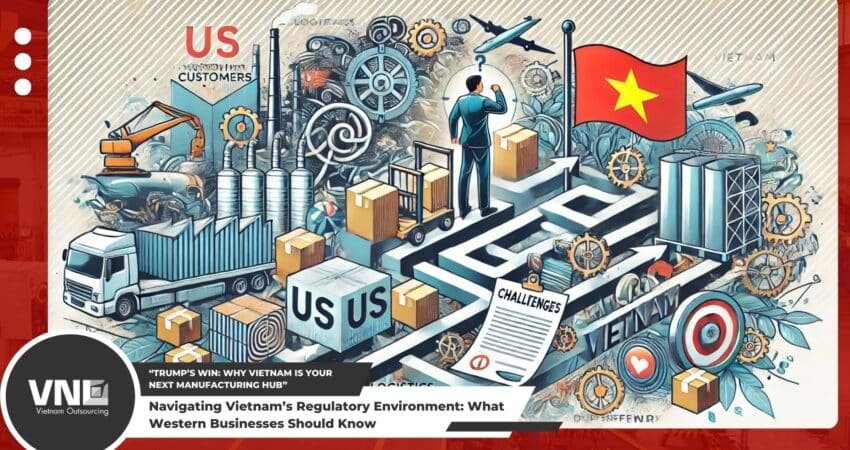Introduction
Vietnam’s rise as a global manufacturing hub has made it a prime destination for Western businesses looking to optimize supply chains. However, navigating Vietnam’s regulatory landscape can be a complex task, especially for companies unfamiliar with local laws, taxes, and export requirements.
In 2024, Vietnam’s regulatory framework continues to evolve to align with its growing role in global trade. Understanding these regulations is critical for businesses seeking to benefit from partnerships with Vietnam factories while avoiding compliance pitfalls. This article provides insights into the legal, tax, and export considerations Western companies must address when outsourcing to Vietnam.
Understanding Vietnam’s Tax and Investment Laws
Taxation and investment regulations are key aspects of Vietnam’s business environment that require careful attention.

Corporate Income Tax (CIT)
Vietnam imposes a standard corporate income tax (CIT) rate of 20%. However, businesses in priority sectors such as metal manufacturing or operating in special economic zones (SEZs) can benefit from tax incentives:
- Four years of tax exemption.
- 50% CIT reduction for the following nine years.
- A preferential CIT rate of 10% for up to 15 years for certain high-tech and large-scale projects.
Example: Companies producing precision machinery or aluminum products in SEZs like the Dung Quat Economic Zone enjoy these benefits, making Vietnam an attractive location for long-term investment.
Value-Added Tax (VAT)
The standard VAT rate in Vietnam is 10%, applicable to most goods and services. However, exported goods, including metal components, copper products, and valves, benefit from a 0% VAT rate, providing cost advantages for Western buyers.
Import and Export Duties
- Import Duties: Raw materials not available domestically are often exempted under Vietnam’s Free Trade Agreements (FTAs), such as the Comprehensive and Progressive Agreement for Trans-Pacific Partnership (CPTPP) or the EU-Vietnam Free Trade Agreement (EVFTA).
- Export Duties: Most finished goods, including sheet metal components and hydraulic press machine frames, are exempt from export duties, making Vietnam a cost-effective sourcing option.
Navigating Labor and Environmental Regulations
Vietnam’s labor and environmental laws are increasingly aligned with international standards, ensuring compliance but also adding regulatory complexities.

Labor Laws
Vietnam’s labor code mandates key provisions that businesses must adhere to:
- Work Hours: Maximum of 48 hours per week, with overtime capped at 200 hours per year (extendable to 300 hours for special cases).
- Minimum Wage: Varies by region, with rates in 2024 ranging from VND 4,680,000 to VND 5,330,000 per month (~$200–$230).
- Social Insurance: Employers must contribute 17.5% of an employee’s salary to Vietnam’s social insurance fund, covering health, unemployment, and retirement benefits.
Understanding and complying with these labor requirements is critical for maintaining smooth operations in Vietnam factories.
Environmental Compliance
Vietnam’s commitment to sustainable manufacturing is evident in its stricter environmental regulations:
- Companies must conduct environmental impact assessments (EIAs) before starting large-scale projects.
- Strict limits on emissions and waste disposal apply to metal manufacturing processes, particularly in die casting and sheet metal forming.
Non-compliance can result in fines ranging from VND 50 million to VND 500 million (~$2,000–$21,000) or project suspensions.
Export Documentation and Requirements
Western businesses must ensure all export-related documentation is in order to avoid delays and penalties.
Key Documents for Export
- Commercial Invoice: Details of the shipment, including pricing and terms.
- Packing List: Specifies the contents and dimensions of each shipment.
- Certificate of Origin (CO): Required for tariff reductions under trade agreements like CPTPP and EVFTA.
- Bill of Lading (BOL): A legal document issued by the carrier detailing shipment terms.
Customs Clearance
Vietnamese customs operate under the Automated System for Customs Data (VNACCS), streamlining the clearance process. However, companies must ensure:
- Accurate harmonized system (HS) codes for exported products.
- Submission of all documents electronically for faster processing.
Free Trade Agreement Benefits
Under the EVFTA, tariffs on many metal products exported to the EU are reduced to 0%, provided exporters meet origin requirements. This makes Vietnam an advantageous partner for Western companies seeking cost savings.
Common Challenges and How to Overcome Them
Navigating Vietnam’s regulatory environment is not without its challenges. Here’s how businesses can address common issues:
Challenge 1: Complex Bureaucracy
Vietnam’s regulatory processes often involve multiple agencies, which can be time-consuming.
Solution: Partner with local engineering and procurement experts who are familiar with navigating government systems.
Challenge 2: Changing Regulations
Vietnam frequently updates its laws to align with global standards, which can create uncertainty for businesses.
Solution: Work with Vietnam manufacturing consultants who stay updated on legal changes and ensure compliance.
Challenge 3: Language and Cultural Barriers
Miscommunication can lead to delays or non-compliance.
Solution: Collaborate with bilingual local consultants to bridge communication gaps and facilitate smoother operations.
Case Study: Streamlining Compliance for Western Companies
Many Western companies have successfully navigated Vietnam’s regulatory environment by leveraging local expertise:
- A German Automotive Supplier: Partnered with a Vietnam manufacturer to produce high-precision metal components for EVs. The local team ensured compliance with tax exemptions under the EVFTA, resulting in a 20% cost reduction.
- A U.S.-based Construction Firm: Outsourced the production of roof jacks and valves to Vietnam, relying on local procurement specialists to manage export documentation and customs clearance, reducing delivery times by 30%.
Conclusion
Navigating Vietnam’s regulatory environment is a critical step for Western businesses looking to maximize the benefits of outsourcing. Understanding local tax laws, labor requirements, and export procedures ensures smooth operations and compliance with international standards.
With its favorable trade agreements, streamlined customs processes, and commitment to global standards, Vietnam offers an attractive proposition for companies sourcing metal components, precision machinery, and other products. By partnering with Vietnam factories and local consultants, Western businesses can confidently navigate the regulatory landscape and unlock the full potential of Vietnam as a global manufacturing partner.


